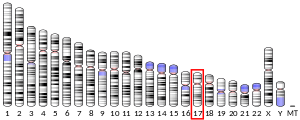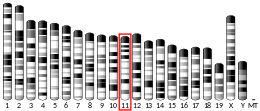CNTROB
Centrobin is a protein that in humans is encoded by the CNTROB gene.[5] It is a centriole-associated protein that asymmetrically localizes to the daughter centriole, and is required for centriole duplication and cytokinesis.[6]
References
- GRCh38: Ensembl release 89: ENSG00000170037 - Ensembl, May 2017
- GRCm38: Ensembl release 89: ENSMUSG00000032782 - Ensembl, May 2017
- "Human PubMed Reference:". National Center for Biotechnology Information, U.S. National Library of Medicine.
- "Mouse PubMed Reference:". National Center for Biotechnology Information, U.S. National Library of Medicine.
- Tchernev, V. T.; Mansfield, T. A.; Giot, L.; Kumar, A. M.; Nandabalan, K.; Li, Y.; Mishra, V. S.; Detter, J. C.; Rothberg, J. M.; Wallace, M. R.; Southwick, F. S.; Kingsmore, S. F. (2002). "The Chediak-Higashi protein interacts with SNARE complex and signal transduction proteins". Molecular medicine (Cambridge, Massachusetts). 8 (1): 56–64. doi:10.1007/bf03402003. PMC 2039936. PMID 11984006.
- Zou, C.; Li, J.; Bai, Y.; Gunning, W.; Wazer, D.; Band, V.; Gao, Q. (2005). "Centrobin: a novel daughter centriole-associated protein that is required for centriole duplication". Journal of Cell Biology. 171 (3): 437–445. doi:10.1083/jcb.200506185. PMC 2171251. PMID 16275750.
External links
- Human CNTROB genome location and CNTROB gene details page in the UCSC Genome Browser.
Further reading
- Jeong Y, Lee J, Kim K, et al. (2007). "Characterization of NIP2/centrobin, a novel substrate of Nek2, and its potential role in microtubule stabilization". J. Cell Sci. 120 (Pt 12): 2106–16. doi:10.1242/jcs.03458. PMID 17535851.
- Lim J, Hao T, Shaw C, et al. (2006). "A protein-protein interaction network for human inherited ataxias and disorders of Purkinje cell degeneration". Cell. 125 (4): 801–14. doi:10.1016/j.cell.2006.03.032. PMID 16713569.
- Wan D, Gong Y, Qin W, et al. (2004). "Large-scale cDNA transfection screening for genes related to cancer development and progression". Proc. Natl. Acad. Sci. U.S.A. 101 (44): 15724–9. doi:10.1073/pnas.0404089101. PMC 524842. PMID 15498874.
- Gerhard DS, Wagner L, Feingold EA, et al. (2004). "The Status, Quality, and Expansion of the NIH Full-Length cDNA Project: The Mammalian Gene Collection (MGC)". Genome Res. 14 (10B): 2121–7. doi:10.1101/gr.2596504. PMC 528928. PMID 15489334.
- Ota T, Suzuki Y, Nishikawa T, et al. (2004). "Complete sequencing and characterization of 21,243 full-length human cDNAs". Nat. Genet. 36 (1): 40–5. doi:10.1038/ng1285. PMID 14702039.
- Strausberg RL, Feingold EA, Grouse LH, et al. (2003). "Generation and initial analysis of more than 15,000 full-length human and mouse cDNA sequences". Proc. Natl. Acad. Sci. U.S.A. 99 (26): 16899–903. doi:10.1073/pnas.242603899. PMC 139241. PMID 12477932.
This article is issued from Wikipedia. The text is licensed under Creative Commons - Attribution - Sharealike. Additional terms may apply for the media files.



